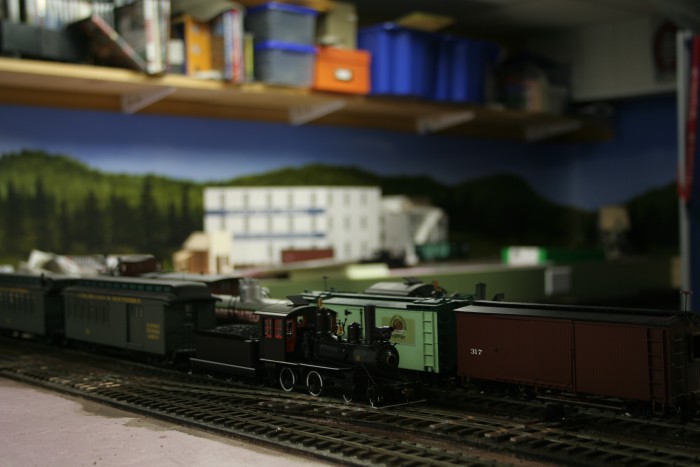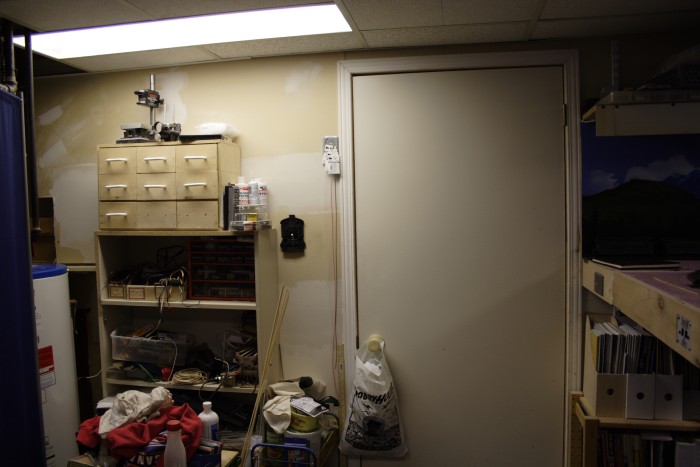Finishing the track at Mara, the first operating session and west of Clearwater
Welcome to volume two of my construction blog, my plan is to start a new blog at the beginning of each year. Well it’s long past due for another update as three months have pasted from the last update. Progress has been made so lets get started.
The track work for Mara has been completed except for the turntable and roundhouse area. I need to figure out how to scratchbuild the turntable pit before the turntable lead can be laid. Right now I’m thinking of using laminated layers of .060 styrene to do this, I just need to figure out a way to cut out the circles.
Seeing as I was scheduled to run an operating session on my layout on February 29, I had to get the rail down and the wiring done. The trackwork was completed by February 26 and the wiring on February 27.
It took 936 cross ties and 116 switch ties to lay the yard and the mainline leading into Mara. Here are some shots of the finished trackwork.
All the switches are accessible from the front of the layout except the yard lead which happens to be behind Lacroix Lumber so I installed a Blue Point Turnout Controller by New Rail Models that I had picked up in Denver. I picked up throw arm and linkage from a local hobby shop that sells a lot of RC plane parts. I like this controller as it has a DPDT switch that lets me power a set of leads on the layout front to indicate the turnout position and another set of contacts that allow me to power the frog.
The first ever operating session on the Clearwater Valley Railway Co. was held on February 29 with 8 operators attending. The operators were spit into 4 crews of 2 working 2 tricks of 2 crews. One crew worked Mara yard while the other crew worked the local between Mara and Clearwater. Once their work was done the second trick took over. This worked out very well and everyone had a great time. The layout was designed with operations in mind and the layout did not disappoint. I figure that when Mosquito Flats and the Okanagan Lumber Co. line are built I’ll be able to keep 4 crews busy on the railway.
A funny thing happened on the way to figure out the operating scheme. As I mentioned earlier I designed the layout with operations in mind. Having the standard gauge line interchange with the CVR really limits the operation as it hard to justify taking a car from the interchange track to an industry in Clearwater so the interchange track will now be in Mosquito Flats. This way, cars can go from the interchange track in Mosquito Flats to Clearwater or Mara. Now this change instigated the name change of the town of Lac La Hache to Mosquito Flats. This is due to the fact that there are no rail lines near Lac La Hache so another town name was required where the interchange was to take place. While there is standard gauge trackage in Clearwater and further south in Little Fort, I like the name Mosquito Flats, which is situated between Clearwater and Little Fort and the Standard gauge line runs close enough to town that there could be an interchange there. Of course this means that I’m going to have to update my history of the railway, but I’ll leave that for another day.
I wanted to finish some structures that I started but seeing as I had a couple of days off during Easter I decided to install the Big Tank Siding behind the furnace and hot water tank. There is not a lot of room to work back there so I built it in the workshop (so to speak) and installed it once it was completed. The goal was to complete it before I went back to work, but my 5 month old Grandson had other ideas so it took a little longer than expected.
The first thing I had to do was modify the existing drain line from the air conditioning coil as is there was not enough space to install the 2 tracks for the siding. A little cutting with the pipe cutter, a couple of extra fittings and a torch the modification took no time at all. Because space was tight I made a template of the benchwork using 1/4″ foam-core. I figured this would be easier than trying to get the plywood in and out until everything fit. Once the template fit I traced the template onto the 3/4″ plywood and cut it out with a jigsaw.
Now it was time to lay out the track centerlines, lay the cork roadbed and track. I must confess I cheated here and used flextrack. Seeing as this are is basicly hidden, I decided to save time by using commercial turnouts and track. In order to control the turnouts I’m using tortoise switch machines to throw the two turnouts at the same time. The controls for these turnouts will be near Clearwater and another set near Mosquito Flats so the siding turnouts can be controlled from both sides.
So what’s on tap next. Well I have about a month before the regional NMRA convention so I’m going to be working on completing the loop, buildings and scenery so the layout will be presentable to visitors. I’ll try to do another update before the convention. If not, it will be after and I’ll let you know how it went.























